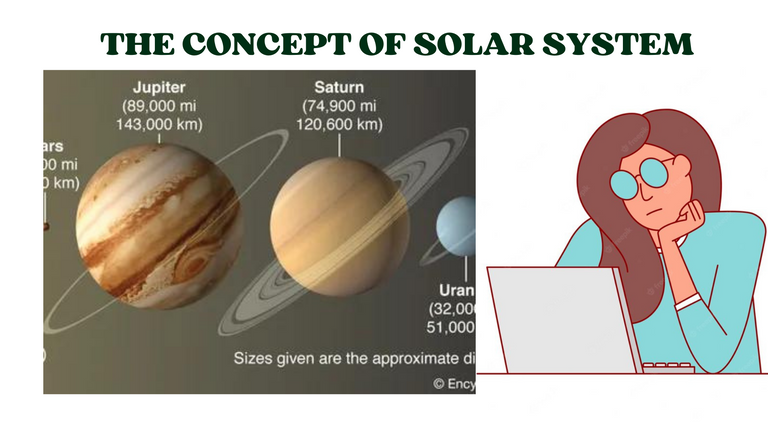The Concept Of Solar System & Their Various Properties
The solar system consists of the Sun, the moon, the eight planets and other heavenly bodies like asteroids, comets, meteors and meteorites.
The planets are celestial bodies which revolve around the Sun. There are eight planets in the solar system consisting of Mercury, Venus, Earth, Mars, Jupiter, Saturn, Uranus & Neptune. At first Pluto was among the planets making nine. But it was later discovered that Pluto is small to be considered as a planet. It's said to be a dwarf plant due it smallest in nature.

The eight planets can be categorized into two. these are the Inner planets and the outer planets. the first 4 planets which are closed to the sun are know as the inner planets or terrestrial planets which includes Mercury, Venus, Earth & Mars. Most of these Inner planets are made of rocky surfaces and mostly solids in nature. They are relatively small in nature and sometimes have unknown number of moons. The Outer planets on the other hand have 4 planets namely Jupiter, Saturn, Uranus and Neptune. We have to take note that Jupiter and Saturn are made up of gases so they are sometimes called gas giant. Their surfaces are made up of hydrogen and helium. Uranus and Neptune contain ice on the surfaces. Methane and ammonia are some of the elements we can find on these planets.
The relative characteristics of the various planets
We have to understand that the planets have various properties that differentiate them from the other planets. It's good to study their properties and know how they are different from others.
Mercury
Mercury is the first planet from the sun. It's very closed to the Sun. Despite it closeness it's not hot as compare to Venus which is the hottest planet. It has a thin and unstable atmosphere which isn't able to absorb much heat as compare to Venus. It's the smallest planet among the rest of the planets in our solar system. It has not atmosphere and hence does not have Moon on it. Mercury take 88 days to revolve around the sun. The temperature of Mercury isn't static but keep varying from 430°C in a day to -180°C.
Venus
Venus is the second planet closer to the Sun. It's characterized by its brightness surface in the sky. It's sometimes appear as morning star in early . morning sky. It's the hottest planet in thee solar system since it contain thick atmosphere which is able to absorb heat. It takes 225 days to revolve around the Sun. Venus doesn't support life due to the surface being dry with no proof of water.
Earth
The Earth is the third planet from the Sun. It is the only planet in the solar system that is known to support life. Since it contains water, atmospheric oxygen, Nitrogen and pressure on it. The Earth has only one moon. It takes 365.25 days to revolve around the Sun and 24 hours to complete one rotation.
Mars
Mars is the Fourth planet from the Sun. The Mars size is about half of the Earth. Mars is sometimes called Red planet due to Iron oxide chemical in the soil look like rust. Mars is characterized by having 2 moons, that's Phobos and Deimos. Atmosphere in Mars is very thin compared to the planet Earth. Mars take 687 days to revolve around the sun and takes 24.6 days hours to finish rotation.
Jupiter
Jupiter is fifth planet from the sun. It's the largest planet among all the planets. It contains a lot of gases so it's normally called gas giant. It's the third brightest planet apart from Venus and the natural satellite Moon. Jupiter takes 4333 days to go round the sun.
Saturn
Saturn is the sixth planet and the second largest planet in the solar system. It's another gas giant like Jupiter. It takes Saturn 10,756 days to revolve around the Sun.
Uranus
Uranus is the seventh planet from the sun. It is ice giant since it surface is full of ice.Most part of Uranus are ammonia,methane and water. It takes Uranus 30,687 days to revolve around the sun.
Neptune
Neptune is the eighth's planet and the 4th largest planet in the solar system. It takes Neptune 60,190 to revolve around the sun.
Galaxy
There are masses of stars found in the night sky. When you cast your eyes upwards, you would see multitude of stars like a dotted points on a sheet of paper. These groups of starts are called a Galaxy. The Galaxy in our solar system in which the Sun is found is called Milky Way Galaxy.
Thanks for your contribution to the STEMsocial community. Feel free to join us on discord to get to know the rest of us!
Please consider delegating to the @stemsocial account (85% of the curation rewards are returned).
You may also include @stemsocial as a beneficiary of the rewards of this post to get a stronger support.
The solar system is a fascinating celestial arrangement, comprising the sun, planets, moons, and various celestial bodies. At the forefront of sustainable energy, the concept of solar systems extends beyond cosmic wonders to terrestrial applications. rv solar panels harness the sun's energy to power recreational vehicles, exemplifying the practical implementation of solar technology. This integration highlights the versatility of solar systems, transitioning from the vast expanse of space to Earth's surface, where renewable energy sources contribute to a more sustainable and eco-friendly future.
Posted using STEMGeeks